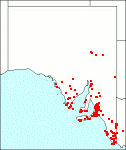Family: Gentianaceae
Centaurium tenuiflorum
Citation:
Fritsch, Mitt. Naturw. Ver., Wien 5:97 (1907).
Synonymy: Erythraea tenuiflora Hoffsgg. & Link, Fl. Portug. 1:354 (1813-20); C. pulchellum sensu H. Eichler, Suppl. 259 (1965).
Common name: Branched centaury.
Description:
Annual up to 35 cm high, usually with one quadrangular main stem but often much-branched, with a basal rosette often not distinct and withering early; leaves oblong-elliptic or lanceolate, rarely ovate, 5-30 x 3-9 mm, usually decreasing to the base as well as towards the inflorescence, obtuse to sometimes acute.
Inflorescence an untidy corymb-like thyrse with one to many dichasia each with a few to many flowers but opposite ones often developing unequally or rarely with terminal monochasia; sepals connate to less than one-third of their length, linear-subulate, 6-8 mm long, usually just shorter than two-thirds the length of the corolla tube, pointed; corolla slender-tubular, yellow; tube 6-9 mm long; lobes lanceolate, 2-3 mm or rarely to 4 mm long, obtuse or acute; stamens with the filaments fused to most of the corolla tube; anthers twisted after the pollen is shed; ovary narrowly ellipsoid, tapering into a style with 2 short broad stigmas.
Septicidal capsule releasing seeds only at the apex.
Published illustration:
Cunningham et al. (1982) Plants of western New South Wales, p. 550.
|
|
Distribution:
|
S.Aust.: FR, EA, EP, NL, MU, YP, SL, KI, SE. W.Aust.; N.S.W.; Vic.; Tas. Native to southern and western Europe.
|
Conservation status:
naturalised
Flowering time: Sept. — Jan.
|

SA Distribution Map based
on current data relating to
specimens held in the
State Herbarium of South Australia
|
Biology:
No text
Taxonomic notes:
Most of the specimens from S.Aust. must be identified as belonging to the subspecies tenuiflorum but others disagree in that they have a distinct basal rosette and/or corolla lodes less than 4 mm long (cf. K. Jakobsen in P. Davis (1978) Fl. Turkey 6:181). However, none of these specimens have the distinctly notched petal apex of subsp. acutiflorum, the second subspecies generally recognised. C. tenuiflorum has often been confused with C. pulchellum (Sw.)Druce which is mainly distinguished by its pedicellate flowers. Eichler (1965) also mentions C. littorale (Turner)Gilmour in connection with the pink-flowered species. Its occurrence in S.Aust. could not be confirmed. C. tenuiflorum is usually easily distinguished from C. spicatum by its few-flowered monochasia, if monochasia are at all present. As the latter branching pattern is usually associated with an atypical spreading habit and many of the lower flowers do not produce fully developed seeds it is thought that these specimens may represent hybrids between the two species.
Author:
Not yet available
|

